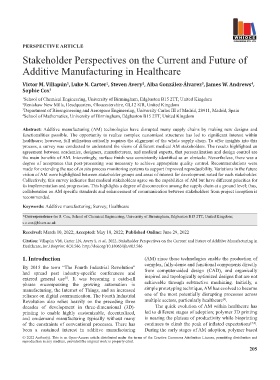Page 213 - IJB-8-3
P. 213
PERSPECTIVE ARTICLE
Stakeholder Perspectives on the Current and Future of
Additive Manufacturing in Healthcare
Victor M. Villapún , Luke N. Carter , Steven Avery , Alba González-Álvarez , James W. Andrews ,
1
2
1
4
3
Sophie Cox 1
1 School of Chemical Engineering, University of Birmingham, Edgbaston B15 2TT, United Kingdom
2 Renishaw New Mills, Headquarters, Gloucestershire, GL12 8JR, United Kingdom
3 Department of Bioengineering and Aerospace Engineering, University Carlos III of Madrid, 28911, Madrid, Spain
4 School of Mathematics, University of Birmingham, Edgbaston B15 2TT, United Kingdom
Abstract: Additive manufacturing (AM) technologies have disrupted many supply chains by making new designs and
functionalities possible. The opportunity to realize complex customized structures has led to significant interest within
healthcare; however, full utilization critically requires the alignment of the whole supply chain. To offer insights into this
process, a survey was conducted to understand the views of different medical AM stakeholders. The results highlighted an
agreement between academics, designers, manufacturers, and medical experts, that personalization and design control are
the main benefits of AM. Interestingly, surface finish was consistently identified as an obstacle. Nevertheless, there was a
degree of acceptance that post-processing was necessary to achieve appropriate quality control. Recommendations were
made for extending the use of in situ process monitoring systems to support improved reproducibility. Variations in the future
vision of AM were highlighted between stakeholder groups and areas of interest for development noted for each stakeholder.
Collectively, this survey indicates that medical stakeholders agree on the capabilities of AM but have different priorities for
its implementation and progression. This highlights a degree of disconnection among the supply chain at a ground level; thus,
collaboration on AM specific standards and enhancement of communication between stakeholders from project inception is
recommended.
Keywords: Additive manufacturing; Survey; Healthcare
*Correspondence to: S. Cox, School of Chemical Engineering, University of Birmingham, Edgbaston B15 2TT, United Kingdom;
s.c.cox@bham.ac.uk
Received: March 10, 2022; Accepted: May 10, 2022; Published Online: June 29, 2022
Citation: Villapún VM, Carter LN, Avery S, et al., 2022, Stakeholder Perspectives on the Current and Future of Additive Manufacturing in
Healthcare, Int J Bioprint. 8(3):586. http://doi.org/10.18063/ijb.v8i3.586
1. Introduction (AM) since these technologies enable the production of
complex, fully-dense and functional components directly
By 2015 the term “The Fourth Industrial Revolution” from computer-aided design (CAD), and organically
had spread past industry-specific conferences and
entered general use . It was becoming a catch-all inspired and topologically optimized designs that are not
[1]
phrase encompassing the growing automation in achievable through subtractive machining. Initially, a
manufacturing, the Internet of Things, and an increased simple prototyping technique, AM has evolved to become
reliance on digital communication. The Fourth Industrial one of the most potentially disrupting processes across
[2]
Revolution also relies heavily on the preceding three multiple sectors, particularly healthcare .
decades of development in three-dimensional (3D)- The quick evolution of AM within healthcare has
printing to enable highly customizable, decentralized, led to different stages of adoption; polymer 3D printing
and on-demand manufacturing typically without many is nearing the plateau of productivity while bioprinting
of the constraints of conventional processes. There has continues to climb the peak of inflated expectations [3,4] .
been a sustained interest in additive manufacturing During the early stages of AM adoption, polymer based
© 2022 Author(s). This is an Open-Access article distributed under the terms of the Creative Commons Attribution License, permitting distribution and
reproduction in any medium, provided the original work is properly cited.
205

